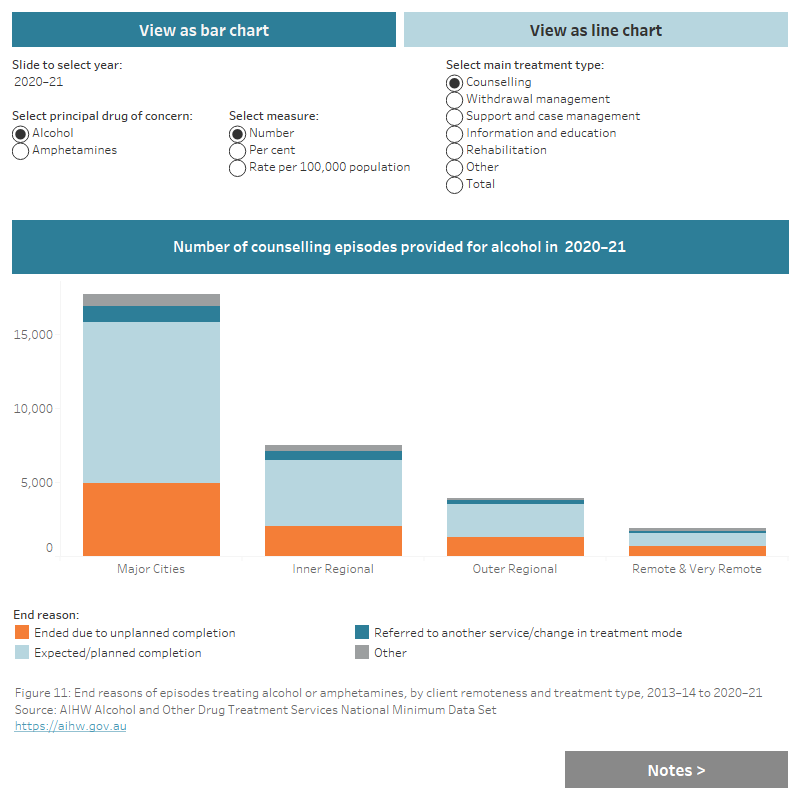Treatment type and remoteness
Geographic location is a prominent factor in treatment accessibility, particularly for clients living or seeking treatment in Remote & very remote areas of Australia (AIHW 2019).
While the greatest numbers of treatment episodes for alcohol and amphetamines were provided in Major cities, accounting for population differences, the remoteness area with the highest rate differed based on principal drug of concern:
- Alcohol: in 2020–21, 953 episodes per 100,000 people were delivered to clients living in Remote & very remote areas, more than 4 times greater than the 229 episodes per 100,000 people delivered to clients in Major cities. The rate of episodes per 100,000 people increased with increasing remoteness, a trend consistently observed from 2014–15 to 2020–21.
-
Between 2013–14 and 2020–21, the proportion of end reasons of episodes treating alcohol remained relatively consistent across most remoteness areas. The exception was Remote & very remote areas, which saw a sharp increase in numbers of information and education episodes in 2018–19 (1,240 episodes, or a 10-fold increase from the previous year) and 2019–20 (2,028 episodes). The majority of this increase was episodes that ended as planned (89% and 97% respectively).
-
- Amphetamines: in 2020–21, clients living in Inner regional areas had the highest rate of episodes (220 episodes per 100,000 people), with the rate of episodes then decreasing with increasing remoteness. This trend is observed in most years from 2013–14 to 2020–21.
For further detail, refer to Supplementary tables BLTN.16 and BLTN.17.
Figure 11: End reasons of episodes treating alcohol or amphetamines, by client remoteness and treatment type, 2014–15 to 2020–21
This interactive data visualisation shows yearly trends in number, proportion and rate per 100,000 population of episodes treating alcohol or amphetamines between 2011–12 to 2020–21. Episodes are presented by reason for cessation, remoteness area and main treatment.

Alcohol
Among alcohol treatment episodes:
- Counselling episodes were delivered to clients in Remote & very remote areas at a much higher rate than other areas in 2020–21 (379 episodes per 100,000 people, almost 4 times higher than Major cities).
- The proportion of planned completions in Remote & very remote areas increased from less than half (44%) in 2016–17, peaking at 54% in 2019–20. In 2020–21, around half (49%) of counselling episodes in Remote & very remote areas had a planned completion.
- Rehabilitation episodes were delivered to clients in Remote & very remote areas at a much higher rate than other areas in 2020–21 (144 episodes per 100,000 people, more than 8 times higher than Major cities).
- The proportion of planned completion was lower in Inner and Outer regional areas (49% each), where there was a higher proportion of episodes where the client was referred to another service or changed their treatment type (around 12% each).
- The proportion of unplanned completion was similar across all remoteness areas (32–36%).
- Withdrawal management episodes were delivered to clients in Major cities and Inner regional areas (46 episodes per 100,000 people in each) at a higher rate than in more remote areas in 2020–21.
- The proportion of planned completion decreased with increasing remoteness (76% in Major cities and Inner regional areas compared to 59% in Remote & very remote areas) in 2020–21.
- The proportion of episodes ending with clients being referred to another service or changing their treatment mode increased (7.4% in Major cities, compared to 18% in Remote & very remote areas) in 2020–21.
Amphetamines
Among amphetamines treatment episodes:
- Counselling episodes were delivered to clients in Major cities at a lower rate (77 episodes per 100,000 people) compared to Inner regional, Outer regional and Remote and very remote areas (117–118 episodes per 100,000 people).
- Episodes delivered in Major cities had a slightly higher likelihood of planned completions (53%) than other regions (48–51%).
- Rehabilitation episodes were delivered to clients in Inner regional areas at a higher rate (35 episodes per 100,000 people) compared to other regions (19 episodes per 100,000 people in Major cities; 25 episodes in Outer regional areas; 17 episodes in Remote & very remote areas).
- Rehabilitation episodes delivered to clients from Major cities, Inner regional and Outer regional areas had similar proportions of unplanned completion (39–41%), higher than those delivered to clients from Remote & very remote areas (29%).
AIHW (2019). “Alcohol and other drug use in regional and remote Australia: consumption, harms and access to treatment, 2016–17.” Cat. no. HSE 212. Canberra: AIHW.
AIHW (2022). Alcohol and other drug treatment services in Australia annual report.


